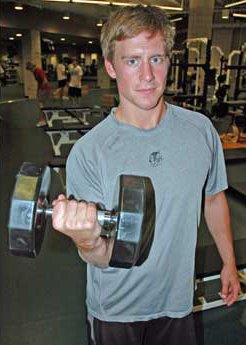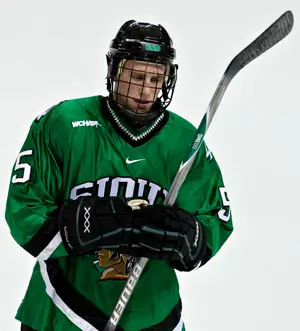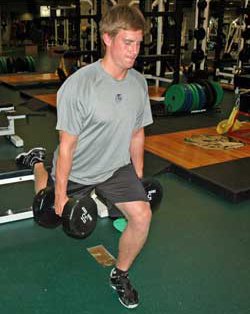When you’re a hockey player who can’t play hockey, an athlete who can’t work out and a student who can’t study, you have a lot of time to think.
North Dakota defenseman Chay Genoway has been doing a lot of thinking about head injuries, about rules, about equipment and about the upcoming college hockey season. It has been more than eight months since he suffered a concussion that ended his season after just nine games. Since receiving a medical redshirt from the NCAA, he has resumed his normal summer training routine and plans to return to the Fighting Sioux next season.

“I’m going to be little rusty on the ice because I haven’t skated for so long,” says the Morden, Manitoba, native. “I haven’t worked out as much as I would have liked in the last eight months. I’m going to lose a little bit of my timing. I think that by October, I’m feeling like I should be ready to go. I’m sure I could take a pretty good bump now.”
After seeing college hockey, the NHL and Canadian leagues grapple with the issue of hits to the head following devastating injuries to players, Genoway says: “I think these leagues need to crack down on the players and let them know that they are being serious about it. It needs to be taken care of in the right manner.
“The rules need to be in line because it’s clearly a problem in all different leagues, and it’s been going on for a couple years now,” he continues. “I think there have been enough incidents in all leagues. I don’t think there needs to be any more.”
Genoway believes that NCAA is on the right track by making hits to the head an automatic 5-minute major with either a game misconduct or game disqualification, although he says intent should also be a factor.
“It seems that there’s a major respect issue that needs to be addressed in all leagues at a high level,” he explains. “I like the hitting in the game because it’s a huge part of the game. What’s tough is the intent when players get their elbows or hands up. Defining a hit to the head, there’s a gray area that comes into it. Judging intent would be tough to actually put in a rule.”
Genoway doesn’t believe the new NCAA rule will make the game less physical or less enjoyable for the fans.
“I don’t think people come to a hockey game to watch a big hit to the head,” he says. “A big, clean body check is a shoulder-to-shoulder hit the fans can cheer about. They come to watch exciting hockey and exciting goals.”
As for the proposal by College Hockey Inc. for the NCAA to do away with full face shields and cages in favor of half-shields, Genoway agrees with it.
“I think guys play a little recklessly with a cage, as opposed to if they played their four years with a half-shield,” he says. “I think going from juniors with the half-shield to a cage and then back to a half-shield can be confusing for players. I think it can cause a bit of recklessness.
“In our league, we’re all preparing for the professional ranks,” Genoway adds. “I think all the rules and equipment and the way things are reffed and handled should be as close to the NHL or professional level as possible. I think the half-shield would be a good idea.”
Season Gone in a Flash
Last year, Genoway, the 2009 WCHA defensive player of the year and captain of the Fighting Sioux, was having the type of senior season most expected. Some considered him Hobey Baker Award material. North Dakota was 7-1-0, ranked second in the nation and Genoway was tied for the team lead in scoring with four goals and six assists.

Then, in the blink of an eye, it all changed. At Ralph Engelstad Arena in a game against St. Cloud State, an elbow from behind stapled Genoway’s head to the glass. It happened so fast that the officials at first threw the wrong Huskies player out of the game.
Eventually, SCSU center Aaron Marvin was assessed a major for checking from behind and a game misconduct. The WCHA later added a one-game suspension for the hit on Genoway.
“I never lost consciousness,” Genoway says. “I knew I had my bell rung. I’d had my bell rung before. It seemed a little different. I knew where I was and all that. It was one of those things. I knew I probably shouldn’t finish the game. I kind of had the idea that something was wrong. I had a headache.
“The following day, I actually went out for the pregame skate to see how I felt,” he remembers. “I just didn’t quite feel right. I thought I’d take a couple days off. I thought maybe in a week I’d be ready to go.”
But that was not to be. The headaches got worse. Genoway couldn’t use a computer. Bright lights bothered him and he had difficulty sleeping.
Genoway, a management major, took his studies seriously. He was named to ESPN The Magazine’s Academic All-America third team in 2009, becoming just the second Sioux player to earn that honor. He was also a WCHA scholar athlete in 2008 and 2009.
When he couldn’t play hockey, couldn’t work out and his school work began to suffer, his stress level went up, which only exacerbated the problems stemming from the concussion. He watched a Sioux team that got off to a hot start go 2-5-2 without him in the lineup.
“You can’t do schoolwork. You go from being at the rink for six hours a day, and that’s taken away from you,” Genoway says. “You’ve got a lot of time to do and try things. I tried it all, but it seemed like nothing worked.
“The worst thing with a concussion is that you get more stress and then you get more headaches,” he notes.
“I’m kind of a high-strung person,” he continues. “I care about the team a lot. I was trying not to stress out, but there I was, worried about how they were doing when the coaches were telling me not to worry about things. I was worried about coming back to help them.”
No Way Back
When UND caught fire and went 12-1-0 from mid-February and into the NCAA tournament, it didn’t make the situation any easier for Genoway. He yearned even more to be back out on the ice with the Sioux.
“I told my teammates I’d try,” he says. “We were making that run and it was hard to just sit there. I’d try to get on the ice, but my heart rate would get to a certain place, and then I’d get the headaches. So I tried to come back in the months of February and March.”
Despite the difficulties, there were highlights. Although Genoway had played few games during the season, he was named to the All-WCHA third team. And then at the Xcel Energy Center in St. Paul, Minn., during the WCHA Final Five tournament, the Sioux became just the second team to win the Broadmoor Trophy by winning three games, defeating SCSU in the championship game. His teammates wouldn’t accept the trophy without him.
“I did not want to go up and get that trophy because it was not mine to get,” Genoway says. “For them to push me out there was pretty special. It’s something I’ll never forget.”
When Yale ended UND’s season on March 27 in the NCAA regionals, trying to get back on the ice to play became a moot point. Genoway focused on resting through April. He also finished his exams from the previous semester and the current one.
“That was really tough to do,” he says. “It still bothered me to use a computer. School was tough, but I survived it.”
Working Through It
During May, he started thinking about why his recovery was taking so long.

“Rest was the best thing, but it turned out, in the end, that exercise was the best way to get out of my funk,” Genoway says. “I worked my way out of it in the end.”
He resumed full workouts before the month ended. And he started getting better.
“It occurred to me that for six months, my body was doing something I wasn’t used to,” Genoway says. “I’d been idle. Any other injury — a shoulder injury, a knee injury — at least you can be somewhat active to work your way out of it.
“Here I’d gone from being an extremely active athlete to doing nothing,” he says. “My body was like, ‘What’s going on?’ I was out of shape.
“As I started working out, I still had mild headaches,” Genoway says. “As I worked my way out of it for a couple weeks, the headaches started being less and less. Here we are and now I don’t get them.”
Genoway won’t discuss the medical details of his current status, and coaches are prohibited by federal law from disclosing such information. But he plans to be playing for North Dakota when the season begins in October, and he hopes his teammates give him the opportunity to captain the team again.
“Summer feels like it’s gone by fast, but not fast enough,” Genoway says. “I’m ready for October. It’s been too long.”


